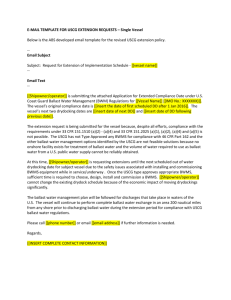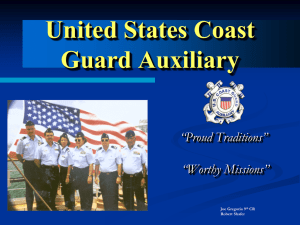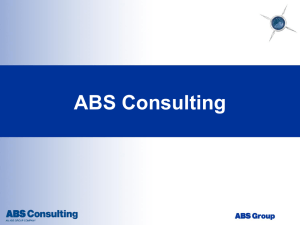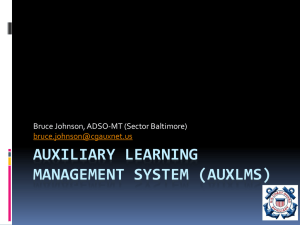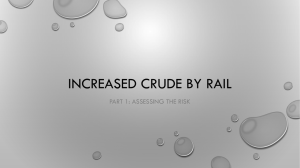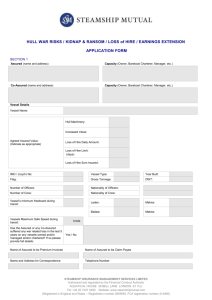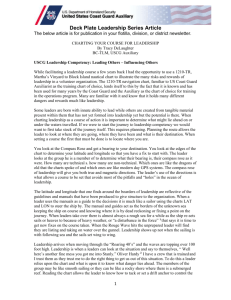The MER is available here.
advertisement
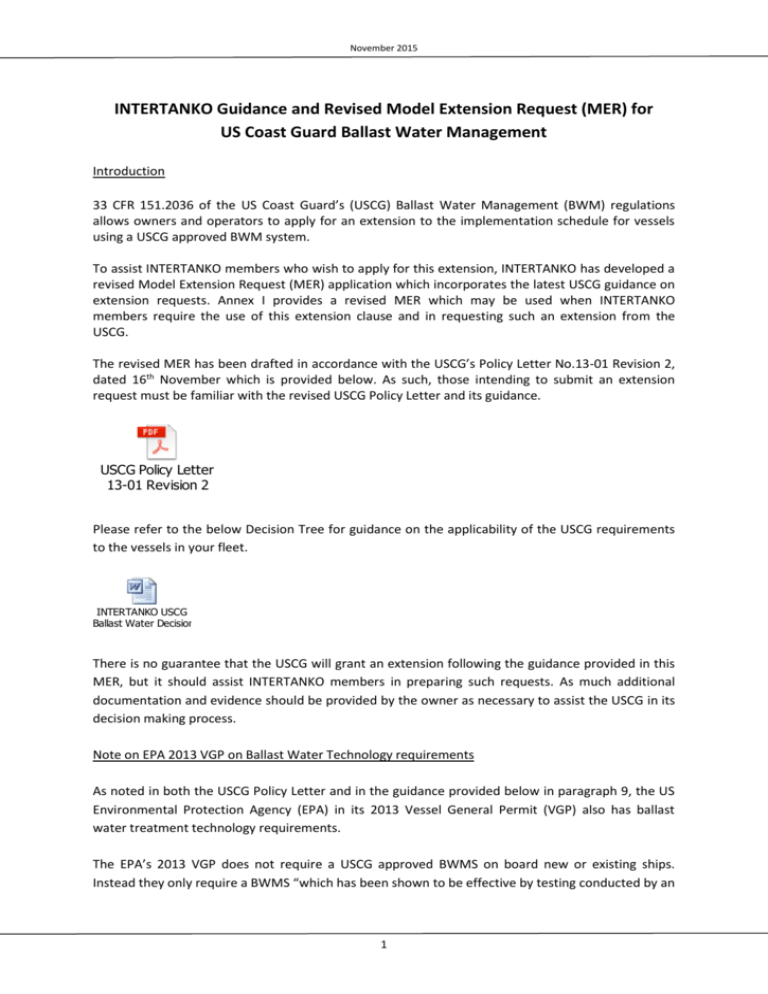
November 2015 INTERTANKO Guidance and Revised Model Extension Request (MER) for US Coast Guard Ballast Water Management Introduction 33 CFR 151.2036 of the US Coast Guard’s (USCG) Ballast Water Management (BWM) regulations allows owners and operators to apply for an extension to the implementation schedule for vessels using a USCG approved BWM system. To assist INTERTANKO members who wish to apply for this extension, INTERTANKO has developed a revised Model Extension Request (MER) application which incorporates the latest USCG guidance on extension requests. Annex I provides a revised MER which may be used when INTERTANKO members require the use of this extension clause and in requesting such an extension from the USCG. The revised MER has been drafted in accordance with the USCG’s Policy Letter No.13-01 Revision 2, dated 16th November which is provided below. As such, those intending to submit an extension request must be familiar with the revised USCG Policy Letter and its guidance. USCG Policy Letter 13-01 Revision 2 Please refer to the below Decision Tree for guidance on the applicability of the USCG requirements to the vessels in your fleet. INTERTANKO USCG Ballast Water Decision Tree There is no guarantee that the USCG will grant an extension following the guidance provided in this MER, but it should assist INTERTANKO members in preparing such requests. As much additional documentation and evidence should be provided by the owner as necessary to assist the USCG in its decision making process. Note on EPA 2013 VGP on Ballast Water Technology requirements As noted in both the USCG Policy Letter and in the guidance provided below in paragraph 9, the US Environmental Protection Agency (EPA) in its 2013 Vessel General Permit (VGP) also has ballast water treatment technology requirements. The EPA’s 2013 VGP does not require a USCG approved BWMS on board new or existing ships. Instead they only require a BWMS “which has been shown to be effective by testing conducted by an 1 November 2015 independent third party laboratory, test facility or test organization.” As the BWMS under the VGP does not have to be approved, the EPA did not include an extension provision in the 2013 VGP. Thus, for the time being, for new ships (keel laid after December 1, 2013) if they want to discharge ballast water in US waters, they will need to install a BWMS to comply with the VGP. The assumption is that these ships would have installed an AMS to meet this requirement, but that would only be good for five years and after that they would have to install a USCG approved BWMS which would meet both USCG and 2013 VGP requirements. INTERTANKO will continue its dialogue with the EPA on this matter and advise members if there is any change in their policy. Completing the Extension Request application Annex I provides a Model Extension Request application. The text in the MER can be used by INTERTANKO members to file an extension request. In the MER however, there are options for the company and notes of guidance. These are distinguished as follows: Text in standard Times New Roman is proposed for use in the MER application. Text in [italics and yellow] require the user to consider the options provided and complete as necessary. Due consideration should be given to the following points when completing an filing the extension request: 1. An Extension Request must be filed 12 months before the original compliance date for the vessel. In certain circumstances, a party may be unable to meet the 12 month requirement (e.g., establishing new ownership of the vessel). In such cases, the extension request should be submitted as early as possible with supporting documentation justifying the party’s reason for not meeting the regulatory deadline. 2. The USCG determines original compliance date by the following implementation schedule as listed in 33 CFR 151.1512(b) or 33 CFR 151.2035(b): a. For vessels constructed on or after December 1, 2013: the date of vessel delivery. b. For vessels constructed before December 1, 2013, and i. having less than 1500 m3 ballast water capacity: the date of the first scheduled drydocking after January 1, 2016; or ii. having 1500-5000 m3 ballast water capacity: the date of the first scheduled drydocking after January 1, 2014; or iii. having greater than 5000 m3 ballast water capacity: the date of the first scheduled drydocking after January 1, 2016. 3. The revised Policy Letter states that a vessel’s extended compliance date will now be the next scheduled drydocking after the vessel’s original compliance date which will be reflected in a 2 November 2015 revised approval letter. However, the application of this Policy is not automatic and an extension request must be submitted to the USCG. The USCG add that existing extension letters will not be re-issued, but the change in terms will be made when a vessel applies for a supplemental extension. 4. Extension requests must be written in English and submitted electronically as an e-mail, with an application spreadsheet (see Annex III for the format for the application spreadsheet) to: environmental_standards@uscg.mil 5. The header to the email must include the term ‘Extension Request’, e.g. “Extension Request Application – Vessel / Company Name”. 6. Extension requests may be submitted as a batch for vessels with same calendar year of original compliance date, and same reasons why they cannot comply with requirement, so the Coast Guard can process similar company vessels at the same time. In this case, complete one spreadsheet for all vessels in the batch with the file name, "BWM extension application – vessel or company name". 7. The details and information on the vessels should be submitted using the USCG application spreadsheet as can be found on the USCG website: http://homeport.uscg.mil/ballastwater The same document is provided below: Enclosure Template for Vessel Details and Information 8. Section 6(a) on procedures for extension application explains what circumstances may merit an extension request. This specifically states the limited availability (or no availability) of USCG typeapproved BWMS (including constrained shipyard capability and capacity to install the system prior to the deadline) and lack of availability of, or ability to use exclusively, water from a U.S. public water system. With no USCG type-approved BWMS currently available then this forms the basis for requesting an extension. 9. Once a USCG Approved BWMS has been made available then the USCG will require more extensive documentation to support the case for not installing the BWMS on a particular vessel. This is particularly relevant in relation to shipyard capability and capacity to install a BWMS, as noted, however, an owner/operator is also advised to assess the USCG type-approved BWMS’s applicability to the vessel in question, for example, by reviewing the flow rates at which the BWMS has been approved and tested as well as its applicability to tankers in regards to explosion proof certification. 10. INTERTANKO will endeavour to advise members of any developments relating to the progress of the USCG in type-approving a BWMS. However, members are advised to keep track of developments in relation to USCG type-approved BWMS by periodically reviewing the USCG Homeport website: http://homeport.uscg.mil/ballastwater 3 November 2015 11. Any additional documentation to support the argument provided in the MER should also be submitted. For example, the shipyard may be able to provide written confirmation that it is unable to install a USCG Approved BWMS. 12. Extension request applications will not receive an automatic email to acknowledge receipt. The USCG staff will send each applicant a receipt message in the order received, but the volume of requests for 2016 vessels and beyond prohibits timely acknowledgement of receipt. 13. Once processed by the USCG, extension requests will be answered with a letter from the USCG granting the extension, as necessary. A copy of the USCG’s decision must be kept on board the applicable vessel. The USCG decision letter should be made available upon request to USCG vessel inspectors and port state control officers etc. 14. The USCG have reminded owners and operators that the Environmental Protection Agency’s (EPA) 2013 Vessel General Permit (VGP) also contains ballast water treatment technology requirements. The USCG note that the EPA advise, “where the US Coast Guard has granted or denied an extension request pursuant to 33 CFR 151.2036, that information will be considered by EPA, but is not binding on EPA”. The USCG encourage owners and operators to contact the EPA at the earliest opportunity. As such, INTERTANKO recommends that the Extension Request application, the accompanying documentation as well as the response from the USCG are referenced within the 2013 VGP compliance documentation on board and within the vessel’s Ballast Water Management Plan. 15. If an owner has already received an extension letter issued prior to the publication of the revised Policy Letter, the new terms will be applied when the owner applies for a supplemental extension. Section 6(b) of the revised Policy Letter provides guidance on when to submit a supplemental extension application and the relevant information that is required in such an application. The MER may be used for a supplemental extension by using the second text option provided in the first paragraph of Annex I. 4 Annex I Model Extension Request application (MER) [Date] From: [Insert name of company, individual contact filing the request and email address] To: environmental_standards@uscg.mil Subject: Extension Request Application – [insert name of vessel or in case of a batch application insert company name] As [master/owner/operator/agent/person in charge] of the vessel(s) detailed in the enclosure to this email, the undersigned submits this email to request [Option for new extension applications: “an extension of the original compliance date(s) in the implementation schedule for approved Ballast Water Management Methods as per 33 CFR 151.2036” or Option for supplemental extension applications: “a supplemental extension to the extended compliance date that the vessel has already been granted in USCG letter dated …….”]. In accordance with the guidance provided in Policy Letter CG-OES No. 13-01 Revision 2 (Nov 16 2015) and despite all efforts, compliance with the requirement under 33 CFR 151.1510 or 33 CFR 151.2025 is not possible for the vessels(s) in the enclosure for the following reasons: 1. According to the information on the public Coast Guard Maritime Information Exchange (CGMIX) at http://cgmix.uscg.mil/Equipment/Default.aspx, there are currently no US Coast Guard type-approved BWMS suitable for the vessel(s); 2. Owing to the non-availability of a USCG type-approved BWMS, shipyards are unable to install such systems; 3. There are no suitable onshore facilities or vessels to receive untreated ballast water at the ports and terminals visited by the vessel(s); and, 4. Access to water from a U.S. public water system is not available in the ports and terminals visited by the vessel(s). Subject to a review of points 1 to 4 above, the vessel(s) in the enclosure will install a Coast Guard typeapproved BWMS at the next scheduled drydocking after the approval of a USCG BWMS adequate to meet the needs of this vessel becomes available. The enclosure to this email provides the vessel’s specific information as per section 6(a) of the Policy Letter. The vessel(s) in the enclosure each have a BWM plan that will be followed for discharges that take place in waters of the U.S.. The BWM plan(s) state that the vessel will [conduct ballast water exchange/use an AMS] during the extension period. In situations where the vessel uses ballast water exchange, the vessel will conduct a complete ballast water exchange in an area 200 nautical miles from any shore prior to discharging ballast 5 Annex I water into waters of the U.S., unless the provisions of 33 CFR 151.2040 apply, or otherwise if so required by a U.S. state. [Insert name of company] has monitored closely the development and approval of BWMS both at an international (through the International Maritime Organization – IMO) and at a US level. In terms of the latter, we note the US Coast Guard’s ongoing approval of BWMS through its Alternate Management Systems (AMS) scheme and the increasing number of manufacturers undertaking tests at Independent Laboratoies. Using external resources such as our member association INTERTANKO, we have also been able to review and monitor the type of BWMS entering the market and considered as either US Coast Guard AMS or Type Approved according to IMO G8 Standards. However, we remain concerned that the BWMSs being approved through the use of the IMO G8 standard and which are generally those that are approved as AMS will not allow the vessel to consistently and reliably discharge ballast water treated in compliance with the USCG discharge standard. Notwithstanding these concerns, [insert name of company] remains committed to the protection of the marine environment and will [continue in its endeavours to find a safe, reliable and compliant BWMS suitable for the vessel(s) in our fleet / ensure the manufacturer of the installed AMS attains CG type-approval]. The undersigned is available for any further information or clarification in relating to this application, the documentation provided and the vessels listed. Yours sincerely, [Insert company representative’s: Contact Name Company Name Company Mailing address Contact Phone number Contact email address Company e-mail address] Enclosure(s): BWM extension application – [vessel or company name] Insert any additional documentation, e.g. from the ship yard and classification society, as necessary. 6
